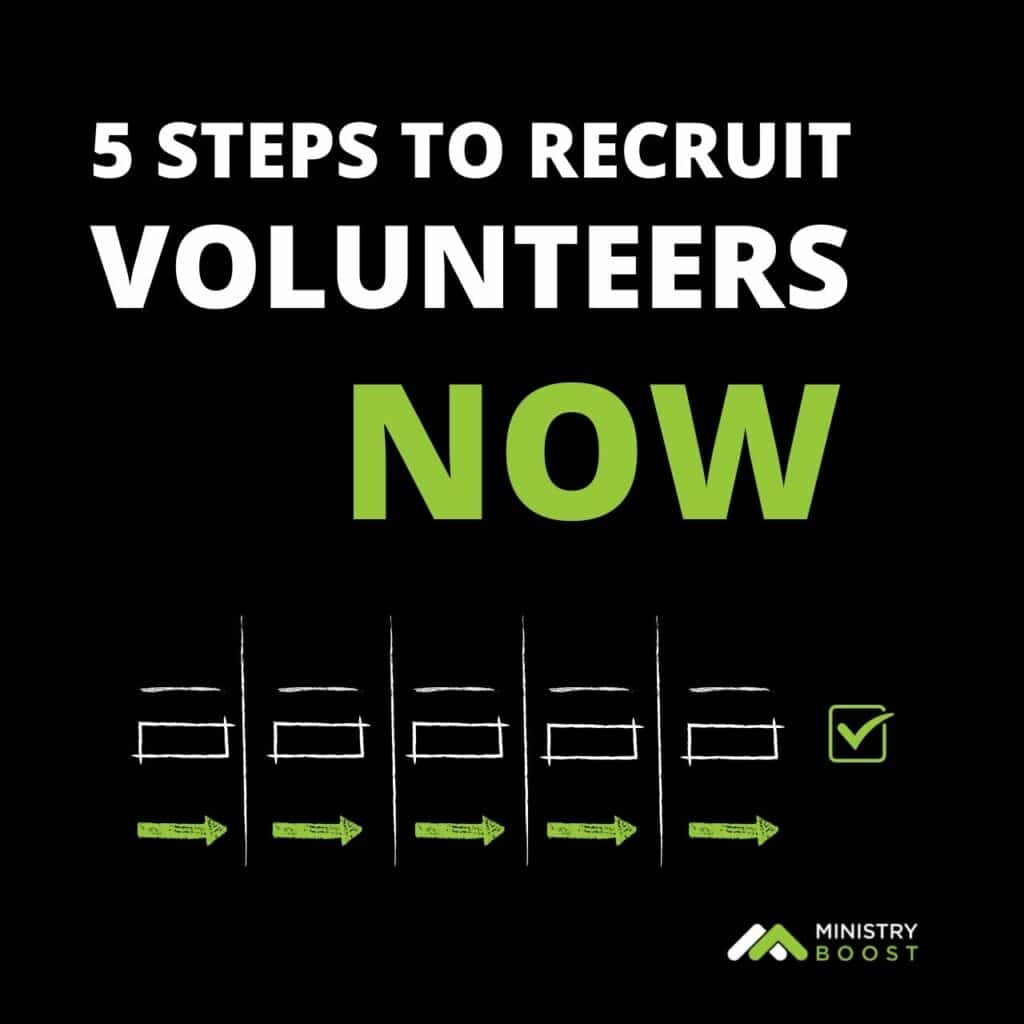Church volunteer recruitment is one of the most critical and most challenging tasks for every church leader. Volunteers are the lifeblood of any church and most church health metrics show a strong correlation between volunteer team growth and the health and growth of the church (see the Unstuck Church Growth reports).
Step 1: Use a System to Recruit Volunteers
First, make a list of prospects who could serve in your ministry. Search your church management system for people who aren't serving, asking current volunteers for names, ask staff for names, look for people in groups/classes but aren't serving, etc.
Second, contact them with an email inviting them to talk briefly on a weekend before or after the service they attend. Indicate you would like to get to know them (if you don't) and hear how they found their way to your church. If you know them, indicate you want to hear how things are going and help them take a step if they're interested.
Third, meet with people and hear their stories. If serving with you seems like a fit, invite them to observe. If not, point them to their best next step.
Fourth, follow up with people you didn't hear back from with an email or maybe even a text. Keep it loose, and don't bug them after this second contact. But, make it clear you expected to hear back from them and didn't.
That system for church volunteer recruitment is expounded on much more in the Volunteer Boost 28-Day Challenge, but you get the idea.
Step 2: Set Aside Two Time Blocks for Recruiting Volunteers
The biggest barrier to recruiting volunteers is that we don't put the time into it. This step will help, as will Step 4. Set aside 2 hours early in the week and another 2 hours late in the week to work on this. Your schedule might look like this:
- Monday – 10am – Contact prospects and people taking steps through onboarding
- Monday – 11am – Work on ideas for Steps 5 & 6
- Thursday 10am – Contact prospects and people taking steps
- Thursday 11am – Firm up conversations for Sunday and add more prospects to contact next week
Turn off email, social media, and maybe even hide somewhere to minimize distractions. Also, block the time out early in the day so it doesn't get pushed out.
Step 3: Onboard Volunteers Intentionally
This is where the Volunteer Pipeline course is helpful because you learn all about how to do this well and you get documents to go along with it. Without the course, you can still make a plan from scratch. Just write out your onboarding process (each step) and use something to track people as they go through it. Your church management system is my top recommendation, but a spreadsheet or Trello can be helpful as well. Make sure you check this system each week to help people take the next step. An awesome strategy for church volunteer recruitment can be waisted if over half of the prospects don't make it through your volunteer onboarding process.
Step 4: Measure Your Volunteer Recruitment and Get Accountability
Ask your boss or someone who can hold you accountable to check in on you at least every other week to update your progress. Talk about who your prospects are, who you have contacted, who is onboarding, and who has been placed. Show them the tracking system. Also, talk about who has stepped off the team (if anyone does). This accountability might be the thing that makes the biggest difference after you get the volunteer recruiting system in place.
Step 5: Use An On-Ramp to Recruit Volunteers Weekly
On-Ramps are natural opportunities for people to volunteer that they experience as part of getting involved in your church. In the course, I share a bunch of them, but if you don't take the course, try this one. Look at the next big event or special weekend you have coming up and recruit volunteers specifically for that event. Invite people who don't currently serve and make the request really clear. Give them a great experience, and after the event, invite them to serve in a regular role.
Step 6 – Recruit Volunteers Through a Boost
Boosts are another thing I teach in the course and they are once-in-a-while recruiting efforts that are bigger. This is probably what people think of when looking for volunteer recruitment ideas. Try this one, a Team Recruiting Competition. Group your volunteers into teams that make sense (3-5 in size) and invite them to recruit at least 1 new volunteer per team. However, make it a fun contest and give away prizes to the teams that recruit the most. Give them 1 month and help them as much as you can (with ideas of who to recruit, reminders of when, deadlines, etc.)
There you go! If you take those 6 steps, I think you'll see results. Check out the Volunteer Boost 28-Day Challenge if you want to go all-in on recruitment.
The more leaders and volunteers you can recruit, the more people your church can reach, as I outline here. As leaders in churches, we all want to recruit the best people possible, because we have the greatest mission to carry out. But, how do you recruit church leaders that are high-capacity? Here are things I have found to be critical.
Creating an attractive environment
I know this is difficult, like the whole chicken and the egg deal. How do you create an attractive environment without already having high-quality leaders? It's a challenge for sure, and the way to start is to make sure you're not doing too much. Cut the things you only do well so you can do the remaining things really well. Maybe you could replace live teaching with video for a season or put a hold on a specific event or program? Use that time and those resources to create the environment you want; the environment you know will be something great people will want to be part of. Recruiting church leaders to poor environments means they won't stick long.
Specialize roles
One of the last things a high-quality leader wants to do is use up their time doing something they are not good at doing. Separate the roles of teaching, leading a small group, editing curriculum, preparing resources and more. In a recent volunteer meeting we had, multiple small group leaders expressed gratitude for being able to show up on Sunday with resources already prepared for them. We want all their best efforts directed to kids and their parents. We want the best teachers teaching, the best worship leaders leading music, etc., and that kind of focus is attractive to a potential leader.
Cast a clear, compelling vision
I've heard vision described as a solution to a problem, with urgency. What problem is your ministry seeking to solve? What problem does that volunteer role help solve? Why is it urgent? Talk about all 3 components whenever you cast a vision for what should be because of your ministry. Sometimes we think of vision as a statement, or something general, but the best way to share vision with potential leaders might be to tell the real story of a child or family whose lives have been impacted by your ministry. There are thousands more families just like them, and you need more leaders on board to help reach them. You can recruit volunteers without a lot of vision, but if recruiting church leaders is your goal, your vision must be clear and compelling.
Ask personally
Nothing beats a personal ask when it comes to recruiting volunteers. The previous 3 steps mostly set the stage for this one. Get to know as many new people as you can on Sundays and don't be afraid to ask them to serve. Challenge your best leaders to ask people as well. Make a competition out of it and challenge a group or room of leaders to recruit a certain number of new volunteers. With your staff or your key volunteers, hold a monthly meeting where you share the detailed numbers of your volunteer teams and hold each other accountable for the growth you want to see.
Volunteer Recruiting Barriers
I have been a part of two churches in my life. My home church I grew up attending and the church I've been on staff with since we started it over 10 years ago. As a young adult in my home church, I volunteered in multiple areas. I never knew I would eventually work for a church, but I always intended on volunteering in a big way.
Our church was like many others in that we did too many things. We also fit the commonly known issue where 20% of the people did 80% of the work. Despite knowing those issues, we did not make the hard decision to change things. Because of that, the volunteer shortage continued and everything we did was understaffed.
The Competition
Make no mistake, there are a lot of things competing for the time and attention of potential volunteers. When someone considers volunteering at your church, they have to think about what they will give up in order to give that time to their role. The last thing we want to do is add competition within the church for that time.
Here is a list of things we might have in our churches that will compete for people's time and negatively impact volunteering. If you are struggling to reach volunteers I would challenge you to consider making the hard decision to remove the competition.
Sunday School
This is a controversial one, but the reality is Sunday School is usually one of the biggest things preventing people from volunteering in our churches. In order for someone to volunteer in children's classes, they must decide to not attend Sunday School. Children's ministry, whatever that looks like in your church, is almost always the biggest volunteer need. How do we expect to serve kids well if potential volunteers are being told two different things about what to do with their time?
Mid-week Programming
If you have mid-week programming for kids and students, in addition to programming on Sundays, you have direct competition for your volunteer's time. Only you can decide how critical mid-week programming is for your ministry, but be sure you factor in the drain it has on your Sunday programming. As you evaluate, determine if the reason you have mid-week programming is simply to function as childcare for programming you have for adults.
One Service
Many churches only have one service, which is completely understandable. This competes for people's time since serving during the service means they can't attend. Churches work around this by having volunteers serve every other week or once every four weeks. One idea would be to start a volunteer-only service before your regular service so they can attend and serve each week. The volunteer service can be scaled back and include some vision elements not found in the regular service.
Other Ministries
In a healthy staff culture, everyone understands they are one team and they must work together when it comes to helping people serve. While it's not easy, they celebrate when one of their volunteers moves on to serve in another ministry.
That's a great thing.
However, most churches have too many ministries and too many programs to the point where, even with people serving on multiple teams, it's impossible to have enough volunteers. Removing competition for volunteers may require cutting a good percentage of your programming.
The Hard Part
Once you have identified where you have competition for volunteering, it's time to take action and remove the competition. That's the hard part, of course, and it will require courageous leadership. It will also require a clear plan of action with careful attention paid to how you will communicate it. I recommend reading Carey Nieuwhof's book Leading Change Without Losing It and using that as a guide.
Boost Volunteer Recruitment by Addressing 3 Fears
One thing I learned along the way is to try to address people's fears about volunteering upfront. Addressing those fears can help someone have the courage to volunteer for the first time. Here are some important fears people have when it comes to volunteering, and how we can address them.
Fear 1: Fear of looking stupid or not knowing what to do
There's a lot of unknown to someone who has never volunteered. They wonder what knowledge or skill is required for the role, and if they have what it takes. The last thing they want is to look stupid because they're not equipped. We can address this fear by providing adequate training on the front-end and communicating the availability of it during recruitment. Before the sign-up, they won't know that training is provided so it's important to find ways to say that when we're inviting them to serve.
Fear 2: Fear of having to serve forever
It seems counterintuitive, but we can actually boost volunteer recruitment by only asking volunteers to serve for a shorter time. It seems counterintuitive because if we give them a specific end date, won't a bunch of them not come back to serve, and then we'll need even MORE volunteers? You would think that, but that hasn't been my experience. I think the freedom they get by seeing an end date and then needing to re-commit each year actually helps more volunteers stick.
Many people have experienced some level of volunteering before, and most volunteer roles have no end date. People are afraid to serve if they think it's a life-long commitment. We can address this fear by having specific volunteer commitment lengths that are one year or less. People can re-commit each year. Another option is to communicate upfront that it's okay to step down whenever they need to, and how they can go about doing that. All of this should be communicated in some way when we're inviting people to volunteer.
Fear 3: Fear of not enjoying their volunteer role
This is linked somewhat to the previous fear, in that they'll feel stuck in something they don't enjoy. This fear is different, however, because they simply want to enjoy whatever they sign up for. We can address this fear by valuing volunteer fit over our volunteer needs. Ensure them it's okay to change roles if it's not a fit after some time. Tell them they can even decide to serve in another ministry. We're all on the same team and we can help boost volunteer recruitment church-wide by working together to make sure people enjoy their volunteer role.
If we address these 3 common fears that people have about volunteering, there's a better chance they will step up to serve.







